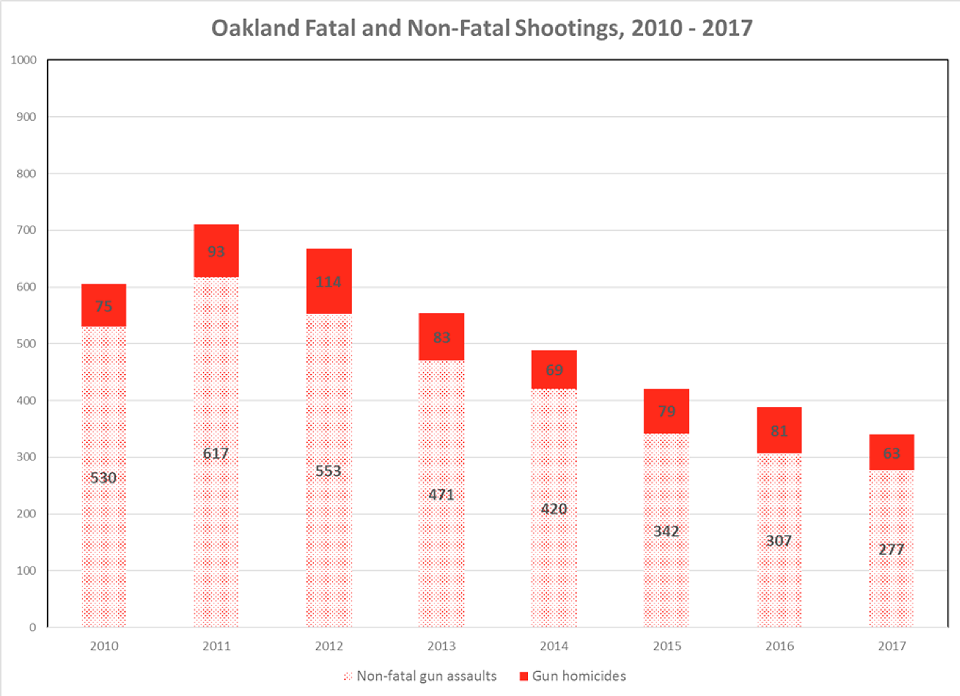Oakland, CA - A new study shows that Operation Ceasefire, Oakland’s primary initiative to reduce group-related gun violence, is a key driver behind the city’s dramatic decline in shootings and homicides since it was launched five years ago.
Researchers from Northeastern and Rutgers University spent months evaluating the impact of the innovative program. See attached for the Oakland Ceasefire Impact Evaluation Key Findings.
Since Oakland city officials, police, and community members launched the collaborative strategy, fatal and non-fatal shootings have decreased in Oakland by more than half, or 52 percent since a peak in 2011.
“Our Ceasefire strategy is about changing behavior, not arresting our way out of the problem,” Mayor Libby Schaaf said. “Our community has come together to offer individuals a new path forward, and this study proves that while we have made great strides to save lives and reduce the trauma of gun violence in our neighborhoods, we still have much work to do.”
Overall, Ceasefire was credited with reducing Oakland’s gun homicides across the city by 32 percent over the past half-decade, researchers said. The study also found that group and gang-involved shootings decreased by 43 percent over the study period.
The program focuses on individuals known to be at the highest risk of committing or becoming a victim of violent crime. Those individuals are provided a range of support and opportunities – including life coach-mentors, social services, support groups, job opportunities, and sometimes cash – to help them reduce their risk of being involved in violence and being incarcerated.
Individuals meet face-to-face with police and community members in confidential “call-ins” to discuss their risks, options, and their futures.
Oakland Police Chief Anne E. Kirkpatrick said, “The critical work that Professor Anthony Braga and the team conducted validates the many years of collaborative efforts in reducing violent crime in Oakland.”
Less than one percent of Oakland’s population was associated with two-thirds of the city’s gun violence, the study reported. Ceasefire focuses on intervening with the high-risk individuals who make up the one percent, the study said.
“The most important individuals that have contributed to this decrease are the young men who made the choice to live and be free because their lives and the lives of loved ones matter,” said Reygan Cunningham, Oakland’s Ceasefire Program Director.
The study also showed no evidence that the gun violence had moved to surrounding neighborhoods or that demographic shifts in the city played a decisive role in Oakland’s crime drop.
The success of Oakland’s Ceasefire program has caught the attention of cities across the nation, said Professor Anthony Braga, Director of the School of Criminology and Criminal Justice at Northeastern University, who led the evaluation.
“The city of Oakland deserves credit for the investments they’ve made to do this important work and to sustain it. They’ve put the structures in place to ensure its success, and a lot of other cities are now visiting Oakland to learn how to do it,” Braga said.
The study marks the first time Oakland has ever developed a citywide strategy to successfully reduce homicides that was supported by a rigorous evaluation.
Still, there were also some criticisms of the program. Researchers found members who participated in the “call ins” were still distrustful of the integrity of the confidential meetings. They also said while violence has decreased in troubled neighborhoods, too much violence persists.
“Until every child in every neighborhood feels the security of living in a safe community,” Schaaf said, “we will continue to improve and work on holistic strategies like Ceasefire to make Oakland safer.”
